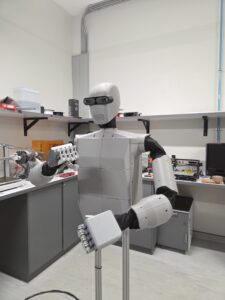The Department of Electrical and Electronic Engineering at Stellenbosch University (SU) introduced an innovative research platform, advancing the field of humanoid robotics. This state-of-the-art platform highlights sophisticated robotics technology and exemplifies the benefits of interdisciplinary collaboration in engineering.

Figure 1: Assembled humanoid robotic research platform featuring a modular torso, dual 6-DOF arms, and dexterous five-finger hands.
The Humanoid Robot in Action
The humanoid robot stands fully assembled, built around a total of 38 degrees of freedom (DOF)—including dual 6-DOF arms, two neck joints, and dexterous five-finger hands on each side—the design closely mirrors human upper-body mobility.
It’s also equipped with a webcam for vision tracking and advanced software, the robot can analyse and replicate human movements in real time, enhancing its human-like functionality. An on-board NVIDIA GPU accelerates vision processing and large-language-model (LLM) inference, enabling voice-initiated commands and natural dialogue with operators.
Dr William Duckitt, a lecturer in the Department, explains: “Our system can perform inverse kinematics, enabling it to follow the motions of a human operator accurately. As a result, the platform can be theoretically teleoperated from anywhere in the world, highlighting its potential for remote operation.”
Pre-launch tests confirm stable millisecond-level control loops and payload handling of up to 1 kg per arm at full extension—ideal for research demos and lightweight tooling.
The platform, built on the EtherCAT communication protocol, accommodates both synchronous and asynchronous processes. All motion, perception, and voice services run as containerised Docker microservices, with React-Automation-Studio dashboards providing browser-based diagnostics and live telemetry. The architecture is designed to manage complex tasks efficiently, leveraging technology previously applied in particle accelerator control systems.
Recognising the potential of humanoid robotics, the department is engaging students in cutting-edge projects. Several final-year undergraduate initiatives are currently in progress, focusing on developing custom actuators, advanced robotic hands, and humanoid arms with pincer grips.
One stream is developing high-torque servo replacements that will raise the robot’s payload target to 10 kg without sacrificing EtherCAT compatibility, while another aims to expand each hand from 12 DOF to 21 DOF for full finger articulation.
These projects provide valuable practical experience. “Our goal is to nurture the next generation of researchers who will advance to master’s programs and make significant contributions to this field,” Duckitt adds.
Going Forward
Future research will focus on creating actuators for the robot’s legs to enable bipedal walking. This development marks a significant milestone towards building a fully mobile humanoid robot capable of realistic human movement and interaction. The team also plans to integrate vision-language-action models so the robot can interpret spoken instructions in context and autonomously plan multi-step tasks.
Moreover, a master’s student in the faculty is also exploring virtual robotics simulations through NVIDIA’s IsaacSim platform. This work centres on sim-to-real transfer, a method that will first apply simulation insights to the robot arm prototype and later enhance the capabilities of the entire humanoid system.
Coupled with reinforcement-learning pipelines, these simulations will accelerate skill acquisition, allowing behaviours trained in the virtual world to port seamlessly onto the physical robot.
“Our journey in humanoid robotics combines our engineering expertise with an academic ambition to push the boundaries of what’s possible,” Duckitt reflects. “We are excited to continue sharing our progress as we advance the field of humanoid robotics.”





